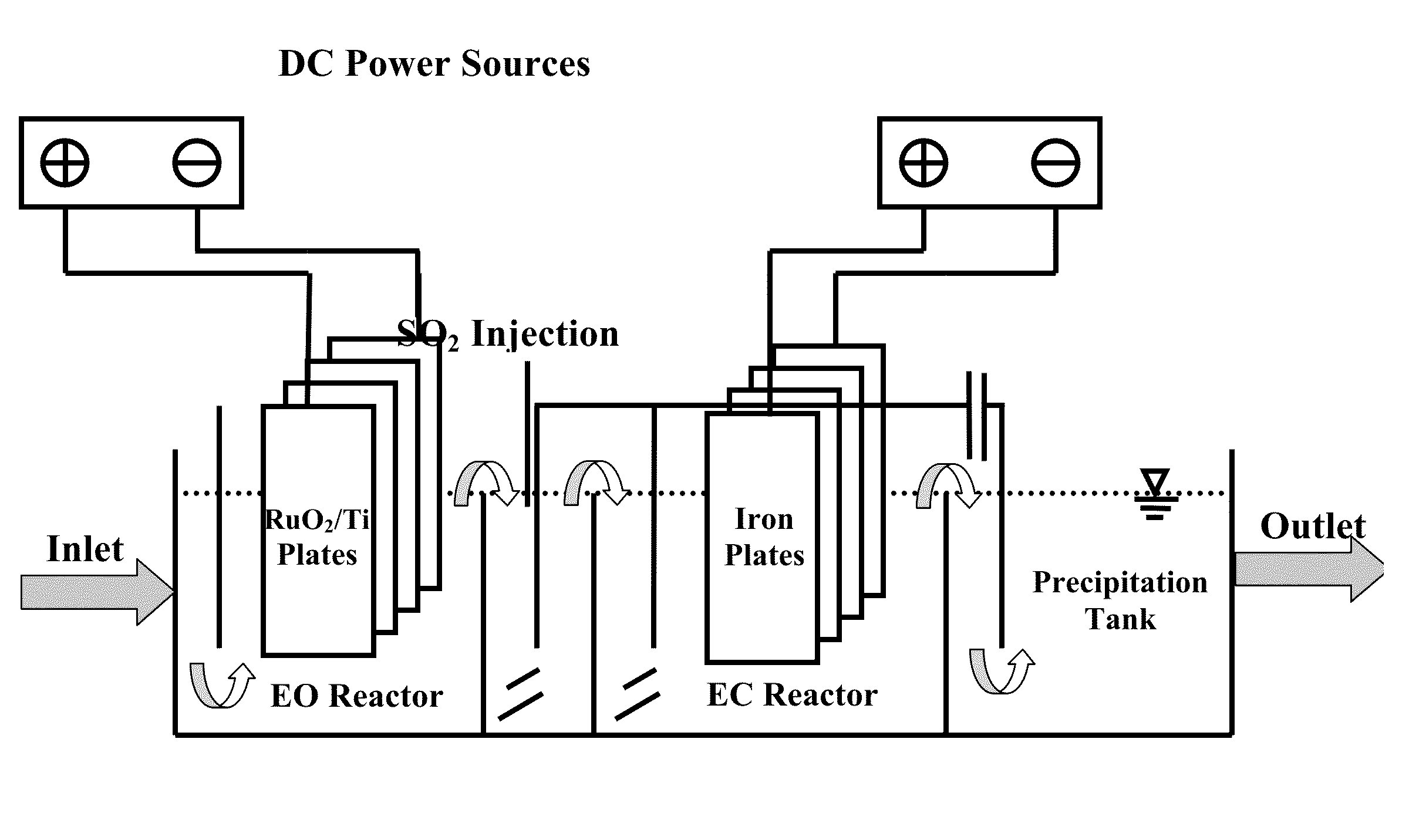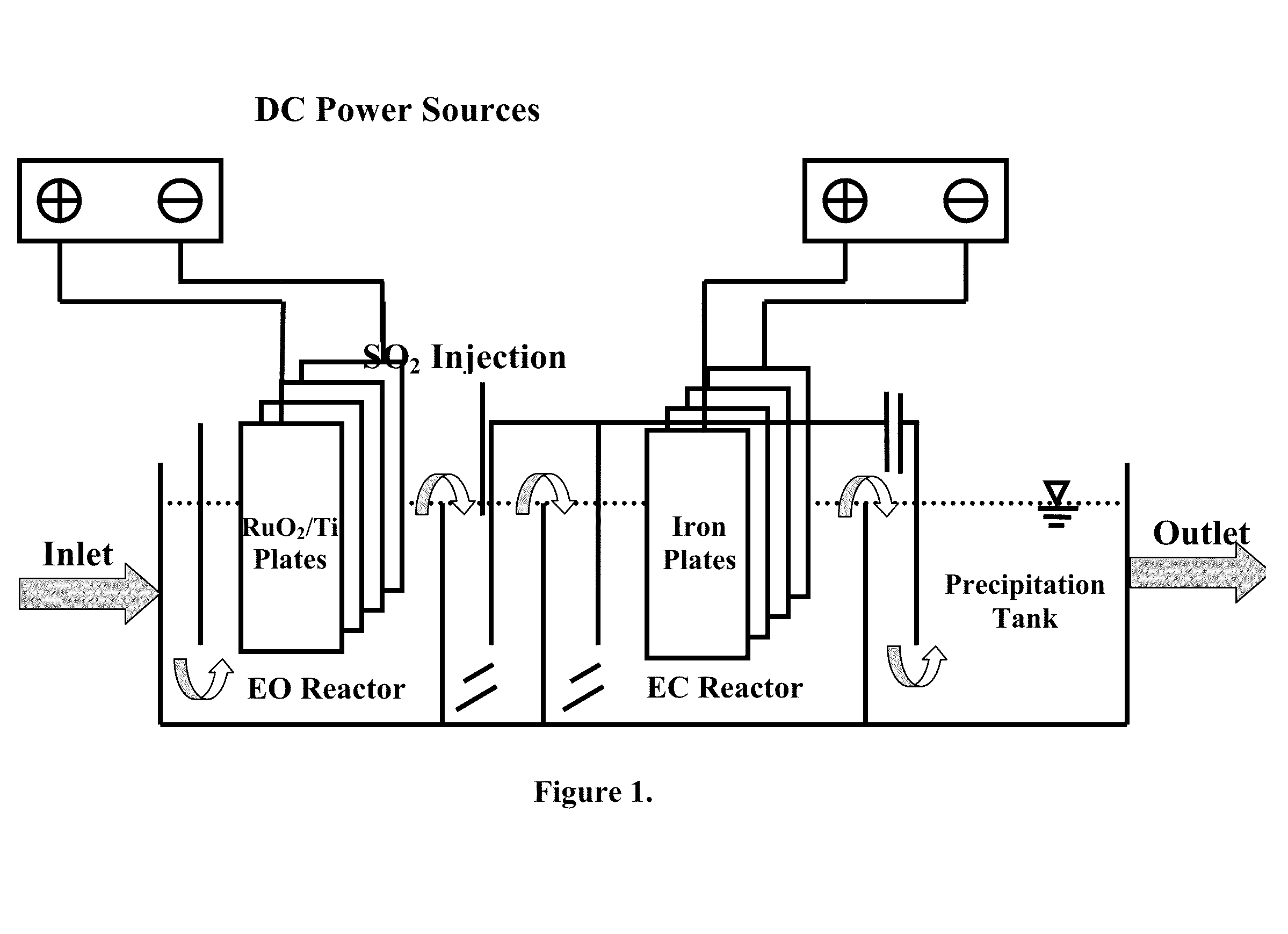Electrochemical-based reactor for the removal of free cyanides and iron cyanide from industrial wastewater
a technology of electrochemical and industrial wastewater, which is applied in the direction of water/sludge/sewage treatment, water contaminants, sedimentation separation, etc., can solve the problems of reactor efficiency problems, decrease in concentration, and process efficiency decline over time, and achieve significant increase in iron consumption, high amount of ferrous ions, and increase in the volume of produced sludg
- Summary
- Abstract
- Description
- Claims
- Application Information
AI Technical Summary
Benefits of technology
Problems solved by technology
Method used
Image
Examples
example 1
[0021]Three concentrations of free cyanide using NaCN and iron cyanide using potassium ferrocyanide and potassium ferricyanide are prepared. Besides, all tests are performed with having 800-1000 ppm chloride ions, due mainly to have actual concentration of this ion in the synthetic wastewater. The wastewater which its pH is adjusted to a pH >10 by using NaOH (preferably between 10 and 11) passes through the first section, i. e. electrooxidation, with the flow rate of 10.8 L / h and current density of 20 mA / cm2 at the anode surface. At the beginning of hydraulically mixing section, sulfur dioxide (SO2) was added to prepare an acidic (pH 3-6) and reductive condition. SO2 reacts with a variety of compounds in the bulk solution. The reaction of SO2 with residual chlorine (OCl−) is done more quickly. Afterwards, SO3−2 reacts with ferricyanide and transforms it to ferrocyanide. Therefore, every increase in the ferrocyanide / ferricyanide ratio is a good indicator for the complete decompositio...
example 2
[0023]In this example, the performance of the reactor is tested under non-ideal conditions in terms of chlorine or cyanide concentrations. The chlorine concentration in this run is 400-500 mg / l, and that of free cyanide is 1500 mg / l. The operational conditions and iron cyanide concentrations are the same as those in example 1. The efficiency of the reactor for free cyanide removal under these conditions is 52% and 87% for the electrooxidation part and total reactor, respectively. As the result indicates, the efficiency of the EO section decreases due to the lack of optimal conditions, but the efficiency of the total reactor proves that the other sections control these situations in terms of decreases of chloride ions and increases of free cyanide concentration.
example 3
[0024]In this example, the performance of the reactor was tested under conditions in which the concentration of ferrocyanide and ferricyanide suddenly increase in wastewater. In this case, the concentration of ferrocyanide and ferricyanide are both changed to 300 mg / l. The operational conditions for other parameters are the same as those in example 1. The efficiency of the EC section for ferrocyanide and ferricyanide removal decreased to 68%, as it was expected. It is due to this reason that the ferrocyanide and ferricyanide removal's efficiency is related to the release of iron from the iron plates in EC section. When the current density 15 mA / cm2, which was applied in example 1, was changed to 20 mA / cm2, the removal efficiency increased to 83%. Although the power consumption increases in such conditions, this test also shows that the reactor is able to control the sudden increase of iron cyanide concentrations.
PUM
| Property | Measurement | Unit |
|---|---|---|
| Current density | aaaaa | aaaaa |
| Concentration | aaaaa | aaaaa |
| Density | aaaaa | aaaaa |
Abstract
Description
Claims
Application Information
 Login to View More
Login to View More - R&D
- Intellectual Property
- Life Sciences
- Materials
- Tech Scout
- Unparalleled Data Quality
- Higher Quality Content
- 60% Fewer Hallucinations
Browse by: Latest US Patents, China's latest patents, Technical Efficacy Thesaurus, Application Domain, Technology Topic, Popular Technical Reports.
© 2025 PatSnap. All rights reserved.Legal|Privacy policy|Modern Slavery Act Transparency Statement|Sitemap|About US| Contact US: help@patsnap.com



